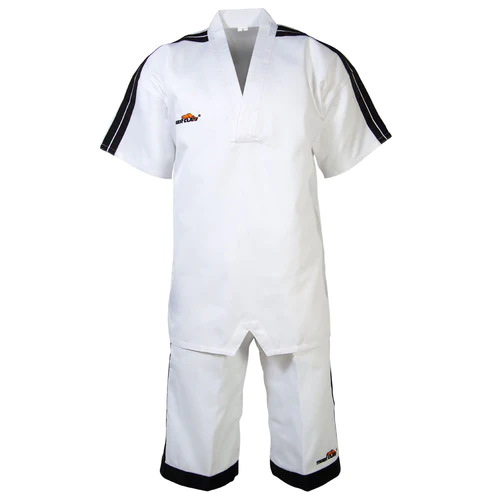 In the latest issue of Kungfu/Taichi magazine, I discussed in my column "Ninja Assassin" More Like Forest Devil Assassin" that although NINJA ASSASSIN is about Japanese ninja, the action fights look more like Chinese martial arts using Chinese martial arts-influenced fight choreography. I further noted that each series of techniques simply ends with a samurai or ninja-like pose. This was written prior to NINJA ASSASSIN's release and based on the trailers and publicity videos. Now, having watched NINJA ASSASSIN, I stand by my words, but my opinion of the film has turned much more positive. Among films with the best ninja action fights where you can actually see what's going on, Kuo Chue's Shaw Brothers film NINJA IN THE DEADLY TRAP (1981) and Ching Siu-tung's DUEL TO THE DEATH (1983) are still tops, but without a doubt NINJA ASSASSIN (NA) is the most exciting and engaging ninja film I have ever seen.
In the latest issue of Kungfu/Taichi magazine, I discussed in my column "Ninja Assassin" More Like Forest Devil Assassin" that although NINJA ASSASSIN is about Japanese ninja, the action fights look more like Chinese martial arts using Chinese martial arts-influenced fight choreography. I further noted that each series of techniques simply ends with a samurai or ninja-like pose. This was written prior to NINJA ASSASSIN's release and based on the trailers and publicity videos. Now, having watched NINJA ASSASSIN, I stand by my words, but my opinion of the film has turned much more positive. Among films with the best ninja action fights where you can actually see what's going on, Kuo Chue's Shaw Brothers film NINJA IN THE DEADLY TRAP (1981) and Ching Siu-tung's DUEL TO THE DEATH (1983) are still tops, but without a doubt NINJA ASSASSIN (NA) is the most exciting and engaging ninja film I have ever seen.
NA is also one of the bloodiest martial arts films ever made. With blatant yet "cute" use of CGI, the movie "ups the ante" on the blood-gushing slice-and-dice style of fight choreography first introduced by the Japanese chambara (samurai sword fighting) films of the 1950s and perfected by Hong Kong kung fu films of the 1970s. These conclusions come from a lifetime of watching martial arts films (more than 4200 in my video collection) as well as my experience in the film industry as a fight choreographer, which started in Chinese kung fu films beginning in 1979 (during my debut film, I helped choreograph samurai fight scenes). But I can assure you that the fights in that film were piddley poop compared to NA. Furthermore, due to some nifty camera work, fight choreography and hard training, non-martial artist Korean actor/singer Rain gives a martial arts pour-formance that rivals the flood of any Chinese non martial arts kung fu star that has reigned over Hong Kong's box office past or present.
SPOILER ALERT. Rain drenches the screen as Raizo, one of the deadliest assassins in the world. Taken from the streets as a child, the orphaned Raizo is transformed into a trained killer by his rough, gruff and heartless surrogate father, Lord Ozuna (Sho Kosugi), the head of Ozunu Clan, a secret society whose existence is considered a myth. But haunted by the merciless execution of his heartthrob Kiriko by his "brother" Takeshi (Rick Yune), Raizo breaks free from Ozuna and vanishes into the shadows of the world. Ozuna and Raizo both become the lifelong number one nemesis of the other, each wanting to exact revenge - one for love, the other for honor and face. END SPOILER ALERT.
Elsewhere, in Berlin, Europol agent Mika Coretti (Naomie Harris) has stumbled upon a money trail linking several political murders to an underground network of untraceable assassins from the Far East. Defying the orders of her superior, Mika digs into top-secret agency files to learn the truth behind the murders as she makes the surreal discovery that the legendary nine ancient clans are real and that they have trained ninja assassins, who kill for 1000 ryos of gold (the Ogami Itto character in the LONE WOLF AND CUB series did it for 500…what a bargain he was). Her investigation makes her a target, and the Ozunu Clan sends a team of killers led by Takeshi to make her lose face (i.e., de-face her). Yet when Raizo saves Mika, he "make a" mockery of the Clan and adds fuel to the clan-destine confrontation in which the result of this cat and rat competition will end in a final conflagration filled with confusion and contusion for all.
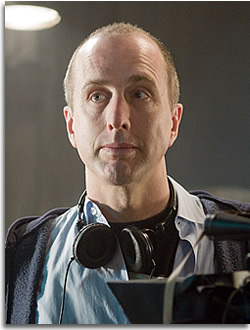 The film's New Zealand-born but Australian-based director James McTeigue shares, "Ninjas were the shadowy characters who always came out of the darkness. When I was growing up in Australia, we got anime from Japan and a lot of the TV serials as well, like THE SAMURAI and THE PHANTOM AGENTS, programs that had elements of the folkloric ninja in them, where the characters were raised in an orphanage or the like. For this film, we talked about those classic elements, but also adding an edgy film noir aspect to it."
The film's New Zealand-born but Australian-based director James McTeigue shares, "Ninjas were the shadowy characters who always came out of the darkness. When I was growing up in Australia, we got anime from Japan and a lot of the TV serials as well, like THE SAMURAI and THE PHANTOM AGENTS, programs that had elements of the folkloric ninja in them, where the characters were raised in an orphanage or the like. For this film, we talked about those classic elements, but also adding an edgy film noir aspect to it."
However, although Rain is the central role of the film, McTeigue admits that the real star of NA is the wild and wooly martial arts sequences as put together by the movie's second unit directors. As luck would have it, the first gig I had in Hollywood was being a fight choreographer for Sam Raimi's TV show SPY GAME, which was the first TV show that stuntman and NA's second unit director Chad Stahelski worked on. Partnering with Stahelski as the other second unit director on NA was Dave Leitch. Both of these lads have worked with producers Joel Silver and the Wachowskis (Andy and Larry) since THE MATRIX days and got their start as stunt coordinators on McTeigue's V FOR VENDETTA
"Part of the objective in making the film was to take it to another level, beyond what we'd all done before," McTeigue continues. "To coalesce all the energies and the disciplines we've had in other movies and bring them into one required a certain level of knowledge and skill, and that's what Chad and Dave deliver every time. They know that stuff inside and out."
Leitch, who I got to know while working on Sammo Hung's MARTIAL LAW, notes, "Ninjutsu (aka ninjitsu), a Japanese style of martial arts, is the main ingredient. However, we incorporated elements of Chinese wushu, an acrobatic type of kung fu, as well as krabi-krabong, a Thai style of sword fighting. We also used a new acrobatic style of sport karate called tricking, and a Filipino martial art called kali, that was taught to us by the legendary martial artist Dan Inosanto.
"I don't think we wanted it to be realistic at all. We wanted it to be over the top. One of our biggest influences for this film, conceptually, was NINJA SCROLL, so when you see blood bubbling up out of a guy's chest, well...it's a visual style. That's what we were going for."
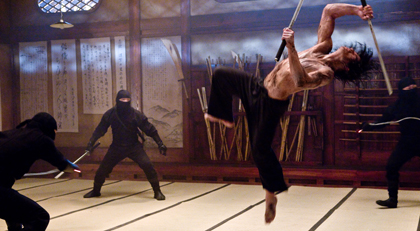
Once McTeigue, Stahelski and Leitch all agreed that they wanted live action stunt work, with no camera tricks, the choreographers invited a wide variety of stunt performers to join in the fun. Leitch continues, "In order to achieve what we wanted, we sought out some younger guys that had really specific skills. Their participation allowed us to get away from the wire-assist standard and to make the stunts about real acrobatics. That was something we always wanted to do."
Stahelski injects, "The wire work is very different on this film from what we did, for example, in THE MATRIX. Our goal was to remove the supernatural element from the wires, remove all 'float,' and focus on human performance. Most of the wires used in the film were just for safety, or for very slight assist. The stunts and martial arts are real and we hired the best."
Artists such as Damien Walters (a five-time world power-tumbling champion from England), Jackson Spidell (famous for his loopkicks and his acrobatic martial arts skills), Jon Valera (a five-time forms champion), Kim Do Nguyen (a World/U.S. forms champion and acrobatic martial arts competitor), Jonathan Eusebio (a former instructor at the Inosanto Academy), Brad Allan (one of Jackie Chan's lead team members), Peng Zhang (Jet Li's stunt double), Park Hyun-jin (another of Chan's team members), Xiang Gao (a member of Donnie Yen's stunt team), and the members of Stahleski's 87Eleven stunt team all brought unique skill sets to NA.
"We incorporated parkour," Stahelski further relates, "a discipline of motion, of getting from point A to point B in the most efficient way possible, whether it's under, around or in a direct line over an obstacle like a wall or a fence, and free running, which is the essence of parkour but with more acrobatics and showmanship. We turned to parkour and free running because we wanted the ninjas to move a little differently, not to just run across the shadows, but to swarm or infest whatever location they happened to be in. They were going to be very athletic, very cat-like."
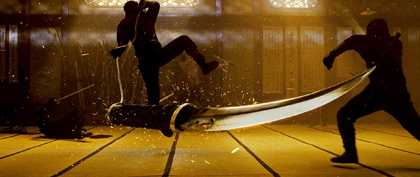
Stahelski and Leitch, self-confessed martial arts nerds, were excited to work with Sho Kosugi as Lord Ozunu. "We're both huge fans," Stahelski says with relish. "He's a master martial artist. I remember the first day he came to our training facility in Berlin, in his sweat suit, with a bag of practice swords. He was in fantastic shape, warmed right up, jumped right in. We thought we were going to have an easy day with him, since he was right off the plane. But he didn't want to stop. He was there for a solid two hours with us, and then was in the gym every day with us after that. His dedication to the craft was extraordinary."
"If you've ever watched any ninja films from the 1980s, you know that Sho Kosugi is the ninja" he is the man," asserts McTeigue. "He was the only person who could impart the discipline of Lord Ozunu. He embodied the clan master."
Although he was playing a bad guy, Kosugi - who has studied martial arts since the age of five and still practices about three hours daily - truly appreciated the thought that went into creating his character. "I was shocked when I saw the script, when I saw the name Ozunu. I smiled because what most people don't know is there was a real Ozunu, who was born in the Kinki District and is the ancestor of the Shugenja, mountain warriors who practiced Shugendo. He's an ancestor of the ninjutsu. So the research was so good. To play this role, I was honored to do that."

And speaking of research, the film has another small interesting twist of ninja information (whether intended or not) that although not entirely correct was on the right track. Although the origin of the ninja is cryptic, certain aspects of history indicate they may have evolved from Korea via the Chinese Tang Dynasty. In A.D. 663, during the Three Kingdoms of Korea (Koguryo, Paechta and Silla Kingdoms), the Tang-backed Silla defeated the Japanese-backed Paechta. It was also during the Tang Dynasty that secret bands of assassins arose, their purpose being to kill corrupt officials. At the same time, the Silla created a secret sect of assassins known as the sulsa, which possibly stemmed from the Tang assassins. Since the Japanese learned many things from their defeat by the Tang-backed Silla, perhaps the Silla's sulsa became the progenitor of the ninja.
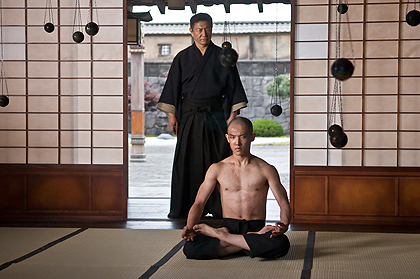
In NA, there's a scene where Persian merchants watch ninjas train in a secret hideout. Historically, in 1078 Persia, Hasan ibn al-Sabbah created secret assassins known as hashashin who practiced Varzesh-e (a Chinese-influenced martial art developed in Persia 17 years after Chinese martial artists visited Persia in 115 B.C.). Linguistically, the Korean and Arabic languages are sister languages, indicating an ancient association between the cultures. Perhaps the hashashin evolved from the Korean sulsa, where NA was maybe inferring that Persia might have learned assassin tactics from the ninja.
Although the fight scenes reflect Chinese style choreography, they are actually shot like the Japanese ninja and chambara films from the 1970s. As I point out in my "to be released in the Spring of 2010" book THE ULTIMATE GUIDE TO THE MARTIAL ARTS FILMS OF THE 1970S, the fights in Japanese film during that decade and now in NA are mostly shot with tight angles using earthquake cam choreography (excessive shaking), feature fountains of squirting blood and arterial sprays, and were filmed in low light, which works for NA since it's about shadow fighters. I personally enjoyed Rain's streamlined and CGI enhanced weapon of choice, the kusarigama, a Japanese weapon that consists of a long chain with a heavy iron weight at one end and a kama (hand sickle) at the other end. The kusarigama was created during the 12th century and was commonly used by ninja as an effective weapon against the samurai sword and naginata (long pole with a thin slicing blade at one end).

How cool is it that this year's best martial arts film is an American production with essentially an all-Asian cast. Perhaps there is still hope for Hollywood, and the film may just open the doors to demonstrate that having a lead Asian actor in a Tinsel Town blockbuster can sell, albeit a sort of stereotypical role (if you view martial arts films as an Asian stereotype). Bring on your opinions of this and tell us if you think a film about ninja (or martial arts films in general) is promoting a stereotype or if it is about respecting an important part of Asian culture.
About
Dr. Craig Reid :
![]() Written by Dr. Craig Reid for KUNGFUMAGAZINE.COM
Written by Dr. Craig Reid for KUNGFUMAGAZINE.COM
![]() Print Friendly Version of This Article
Print Friendly Version of This Article











